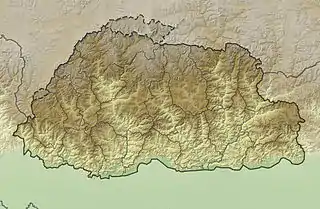Liankang Kangri
Liangkang Kangri (also known as Gangkhar Puensum North[1] and Liankang Kangri) is a mountain peak in the Himalayas on the border between Bhutan and China, as well as at the southeastern end of territory claimed by both countries. Liangkang Kangri is 7,535 metres (24,721 ft) high. To the south, a ridge leads to the 7,570-metre (24,840 ft) Gangkhar Puensum 2 kilometres (1.2 mi) to the south-southeast . Due to the low saddle height of 234 metres (768 ft), Liangkang Kangri is not regarded as an independent mountain. Westward a ridge leads to the 6,680-metre (21,920 ft) high Chumhari Kang. The Liangkanggletscher on the northwest flank and the Namsanggletscher on the eastern flank of Liangkang Kangri form the headwaters of the Lhobrak Chhu, a source river of Kuri Chhu. The glacier on the southwest flank belongs to the catchment area of Angde Chhu.
| Liankang Kangri | |
|---|---|
_(4677022812).jpg.webp) Liankang Kangri and Gangkar Puensum | |
| Highest point | |
| Elevation | 7,535 m (24,721 ft) |
| Prominence | 234 m (768 ft) |
| Listing | Mountains of Bhutan |
| Coordinates | 28°03′50″N 90°26′35″E |
| Geography | |
 Liankang Kangri Location of Liankang Kangri on a map of Bhutan, at the border with China | |
| Location | Bhutan–China border |
| Parent range | Himalayas |
| Climbing | |
| First ascent | 5 May 1999 |
The first ascent of Liankang Kangri was by a 5-member party led by the Japanese mountaineer Kiyohiko Suzuki on 5 May 1999. According to them, Liankang Kangri was the second highest unclimbed mountain in the world, after Gangkhar Puensum.[2] Team member Tamotsu Nakamura commented to the BBC after the party's success, “As I cannot disclose an inside story behind the sudden cancellation, I write only that the reason why the permit was withdrawn was because of a political issue with [the] Bhutan government. (...) I regret that Liangkang Kangri is not an outstanding summit."[1]
References
- Nuwer, Rachel (4 July 2014). "The mountains we have never climbed". www.bbc.com. Archived from the original on 14 September 2018. Retrieved 2019-02-18.
Rather than go home empty-handed, Nakamura and his climbing partners turned to Liangkang Kangri (also known as Gangkhar Puensum North), a 7,441m (24,555ft) unclimbed peak that is firmly planted in Tibet. Although that effort was a success, it was a disappointing end to the trip. As Nakamura later wrote, “I regret that Liangkang Kangri is not an outstanding summit.”
- Tsuguyasu Itami (October 2001). "Gankarpunzum & First Ascent Of Liankang Kangri" (PDF). Japanese Alpine News. 1. Retrieved 7 November 2015.